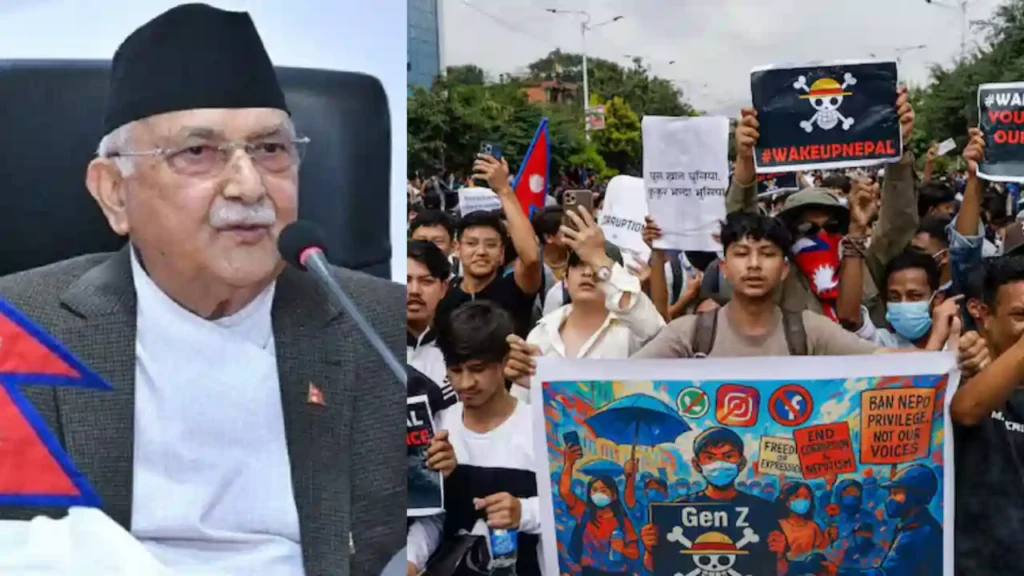New Delhi: Nepal is reeling from an unprecedented youth-led uprising that has claimed at least 22 lives, injured hundreds, and forced the resignation of Prime Minister KP Sharma Oli on September 9, 2025. Triggered by a sweeping government ban on major social media platforms, the protests—driven by Nepal’s Generation Z—have morphed into a broader revolt against corruption, nepotism, and economic stagnation. With curfews in place, government buildings torched, and the army stepping in, the Himalayan nation faces a precarious leadership vacuum. The unrest’s timing, following Oli’s China visit and ahead of a planned India trip, has fueled speculation of geopolitical meddling, though experts emphasize the protests’ roots in domestic grievances.

The Catalyst: A Social Media Blackout Sparks Fury
On September 4, 2025, Nepal’s Ministry of Communications and Information Technology banned 26 social media platforms—including WhatsApp, Instagram, Facebook, X, and YouTube—for failing to register locally, appoint grievance officers, and remove flagged content. In a country with one of South Asia’s highest per capita social media usage rates, the move was a lightning rod. Students lost access to online classes, content creators saw livelihoods threatened, and activists decried an attempt to silence anti-corruption campaigns gaining traction online.
“Gen Z won’t let our voices be silenced,” declared Subhana Budhathoki, a content creator, as hashtags like #NepoBaby and #NepoKids trended, spotlighting the lavish lifestyles of politicians’ families against Nepal’s economic woes. The ban, repealed on Monday night after protests erupted, was the immediate spark, but the kindling had been piling up for years: unemployment, mass migration, and systemic corruption.
The protests began at 9 a.m. on September 8 at Kathmandu’s Maitighar intersection near the Mandala monument. Organized loosely by youth groups like Hami Nepal, a non-profit founded in 2015, thousands gathered—many in school or college uniforms, clutching books. Their placards read “Shut Down Corruption, Not Social Media” and “Youths Against Corruption,” signaling a movement beyond the ban.
From Peaceful Rallies to Violent Clashes
What started as orderly demonstrations quickly spiraled. By midday Monday, protesters, including motorcycle-riding groups, breached police barricades and stormed the Parliament complex in New Baneshwor. Security forces responded with tear gas, water cannons, rubber bullets, and live ammunition. The clashes turned deadly: 19 fatalities were reported that day, many from gunshot wounds to the head and chest, with over 400 injured flooding hospitals like Civil Hospital and National Trauma Centre.
Protesters retaliated with sticks and bottles, setting fire to government buildings, including the Singha Durbar ministry hub, the Nepali Congress Party headquarters, and the residences of Oli, President Ram Chandra Paudel, and former PM Sher Bahadur Deuba. Kathmandu’s skyline choked on black smoke from burning tires, cars, and trucks. By Tuesday, three more deaths raised the toll to 22, with nearly 200 wounded.
Curfews were imposed from 12:30 p.m. to 10 p.m. in Kathmandu, Pokhara, Itahari, and other cities, but demonstrators defied orders. The unrest spread to Oli’s home district of Jhapa, Sunsari (linked to ex-leader Girija Prasad Koirala), Bhairahawa near Uttar Pradesh, and Biratnagar by Bihar. Tribhuvan International Airport partially shut down due to smoke-obscured visibility, prompting Air India to cancel flights and IndiGo to divert routes from Mumbai and Delhi to Lucknow.
Leadership Collapses: Oli and Paudel Resign
Facing mounting pressure, Oli, a 73-year-old Communist leader who assumed office in July 2024, resigned on Tuesday. “In view of the adverse situation, I have resigned to facilitate a constitutional solution,” he wrote to President Paudel, exiting via military helicopter. Paudel followed suit, resigning hours later, plunging Nepal into a leadership void. The Chief Secretary issued a plea for calm, warning against further loss of life and property.
The resignations of Home Minister Ramesh Lekhak and Communications Minister Prithvi Subba Gurung on Monday, citing moral responsibility for the deaths, underscored the crisis’s gravity. Oli, in a multi-party meeting, condemned the violence as against national interests, blaming “infiltrators” and ordering a 15-day probe into the unrest’s causes.
General Ashok Raj Sigdel, Nepal’s army chief, warned that security forces, including the army, would “take control” if looting and arson persisted. He invited dialogue but offered no clarity on interim governance. Reports suggest ministers are seeking refuge with security units, while the army’s presence mirrors military interventions in Sri Lanka (2022) and Bangladesh (2024) after anti-corruption uprisings toppled governments.
Gen Z’s Demands: Corruption, Nepotism, and a Stolen Future
Unlike Nepal’s past political upheavals, this movement lacks traditional party backing. Driven by those under 30, it’s a decentralized, social media-fueled rebellion. Students from universities in Kathmandu, Pokhara, and Itahari, joined by schoolchildren, have rallied under the Gen Z banner. “We want a corruption-free Nepal with education, healthcare, and jobs,” said protester Robin Sreshtha.
The #NepoBaby and #NepoKids slogans, trending for a week before the ban, highlight fury at inequality. Viral TikTok and Instagram videos contrasted politicians’ heirs enjoying luxury cars and foreign trips with ordinary Nepalis’ struggles. Past scandals, like the 2017 Airbus deal that cost the state airline millions, fuel the narrative. Since the monarchy’s end in 2008, 13 governments have failed to address systemic graft and underdevelopment, pushing youth to the edge.
Kathmandu Mayor Balendra Shah, an independent who won via social media campaigns, has emerged as a protester favorite, urging restraint while supporting their cause. Other names like parliamentarian Sumana Shrestha and activist Sudan Gurung are floated as potential PM candidates. Periodic calls for restoring the 239-year-old monarchy, abolished in 2008, add complexity, with pro-King Gyanendra rallies tied to anti-corruption sentiments.
Geopolitical Undercurrents: India, China, and the U.S.
Nepal’s strategic position amplifies the stakes. Oli’s pro-China tilt—evident in his first foreign trip to the SCO Summit in Tianjin and signing the Belt and Road Initiative framework in December 2024—has strained ties with India. His September 16 India visit, invited by PM Narendra Modi via Foreign Secretary Vikram Misri, was meant to mend fences. Oli’s claim over Uttarakhand’s Lipulekh Pass as Nepali territory, raised with China’s Xi Jinping, echoed his 2020 protest over Kalapani and Limpiyadhura, invoking the 1816 Treaty of Sugauli.
Veteran journalist Keshav Pradhan dismisses direct foreign involvement but notes the unrest’s timing—post-China, pre-India—raises questions. “The anger stems from corruption, unemployment, and migration, not sudden external plots,” he says. China’s influence, largely Kathmandu-centric, is unlikely to orchestrate Terai unrest, which could backfire, as seen in 1960s anti-China protests. U.S. investments via the $500 million Millennium Challenge Corporation add another layer, with some speculating Washington’s hand akin to Bangladesh’s 2024 unrest.
India, closely monitoring, issued a travel advisory urging its citizens in Nepal to shelter in place and avoid streets. Uttar Pradesh border districts heightened security. Nepal’s unrest echoes Bangladesh’s student-led ouster of Sheikh Hasina, a pro-India leader, raising fears of external forces hijacking the protests.
What’s Next for Nepal?
With no clear successor, Nepal teeters on the brink. Protesters demand governance reforms and accountability, but the movement’s lack of centralized leadership complicates dialogue. If unrest escalates, especially with civil society joining, analysts warn of deeper chaos. Shah’s social media appeals for calm hint at a potential mediator role.
Nepal’s Gen Z has ignited a reckoning, leveraging digital platforms to challenge a corrupt status quo. As the nation mourns its dead and navigates a fragile future, the world watches whether this uprising births lasting change or descends into further turmoil.
Frequently Asked Questions
1. What sparked the Gen Z protests in Nepal in September 2025?
The protests erupted on September 8, 2025, after the Nepalese government banned 26 major social media platforms, including WhatsApp, Instagram, Facebook, X, and YouTube, on September 4 for failing to register locally and comply with content regulations. This move, seen as an attempt to stifle anti-corruption campaigns, infuriated Nepal’s youth, who rely heavily on social media for education, livelihoods, and activism. The ban, lifted on Monday night after protests began, was the immediate trigger, but deeper grievances over corruption, nepotism, unemployment, and economic stagnation fueled the unrest.
2. Why did Prime Minister KP Sharma Oli resign, and what is the current state of Nepal’s leadership?
Prime Minister KP Sharma Oli resigned on September 9, 2025, citing the “adverse situation” caused by violent protests that killed 22 people and injured nearly 200. His resignation followed that of President Ram Chandra Paudel, leaving Nepal without clear leadership. Oli stepped down to facilitate a constitutional resolution, as confirmed by his aide Prakash Silwal. The army, led by General Ashok Raj Sigdel, has signaled readiness to “take control” if unrest persists, and there’s no confirmed interim government. Names like Kathmandu Mayor Balendra Shah and parliamentarian Sumana Shrestha are floated as potential successors.
3. What are the main demands of the Gen Z protesters?
Nepal’s Gen Z protesters, primarily those under 30, demand the end of the social media ban (now lifted) and sweeping reforms to address systemic corruption and nepotism. They’ve popularized hashtags like #NepoBaby and #NepoKids to criticize politicians’ families for enjoying unearned privileges while ordinary Nepalis face unemployment and migration pressures. Placards with slogans like “Shut Down Corruption, Not Social Media” highlight calls for better governance, access to education, healthcare, and job opportunities, reflecting frustration with unkept election promises and scandals like the 2017 Airbus deal.
4. How have India and other foreign powers responded to the Nepal protests?
India’s Ministry of External Affairs issued a travel advisory urging citizens in Nepal to shelter in place, avoid streets, and follow local directives, while warning against non-essential travel. Uttar Pradesh border districts heightened security due to proximity to protest-hit areas like Bhairahawa and Biratnagar. Speculation about foreign involvement—China via its Belt and Road Initiative, the U.S. through $500 million in infrastructure grants, or even pro-monarchy elements tied to India—circulates, but experts like journalist Keshav Pradhan emphasize the protests’ domestic roots. India advocates for a peaceful resolution through dialogue.
5. What could happen next in Nepal’s political crisis?
Nepal faces uncertainty with no clear leadership post-Oli and Paudel’s resignations. The army’s potential intervention, mirroring Sri Lanka (2022) and Bangladesh (2024), looms if looting and arson continue. Protesters, lacking centralized leadership, demand accountability but risk escalation without meaningful government engagement. Figures like Mayor Balen Shah could mediate, while calls for monarchy restoration add complexity. The outcome hinges on whether dialogue yields reforms or if unrest deepens, potentially destabilizing Nepal further amid its history of 13 governments since 2008.

